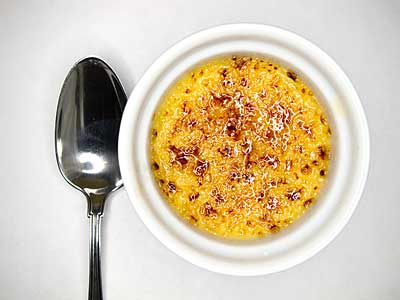October 22, 2012
Mignardise

crème brûlée
(burnt cream)
In front of my cooking classes, I’ve often said that “Life is a custard!” It’s sort of a stupid thing to say, but it gets everyone’s attention. What I mean is that there are so many things that we prepare where we use egg protein to solidify some liquid, either partially or completely, and thus make a custard. What’s the base for ice cream? Custard. What’s the base for many souffles? Custard. What’s the base for bread pudding? Custard. If I take chicken broth, mix a couple of eggs with it, and steam it until it solidifies, what am I making? A Chinese savory custard. Get the idea? Mix the right amount of eggs with the right amount of liquid and add heat, the result will be some form of custard. It may have a different name, but it will still be custard. Life is custard.
There’s nothing new about custard. The Romans had tyropatinam. The fourth-century recipe
Tyropatinam: accipies lac, adversus quod patinam aestimabis, temperabis lac cum melle quasi ad lactantia, ova quinque ad sextarium mittis, si ad heminam, ova tria. in lacte dissolvis ita ut unum corpus facias, in cumana colas et igni lento coques. cum duxerit ad se, piper adspargis et inferes.
was translated in 1936 as
Custard: estimate the amount of milk necessary for this dish and sweeten it with honey to taste; to a pint of fluid take 5 eggs; for half a pint dissolve 3 eggs in milk and beat well there is incorporate thoroughly, strain through a colander into an earthen dish and cook on a slow fire. When congealed sprinkle with pepper and serve.
Except for the pepper, this could easily be a modern custard recipe.
In the seventeenth century, François Massialot gave us the first published recipe for crème brûlée, or “burnt cream.” Still a basic custard, albeit with an orange flavor, but he goes one step farther and finishes the dish with a layer of sugar that is caramelized using small, red-hot shovel, one designed to move hot coals around the fire, held close to the surface.
Later cooks replaced the shovel with a round, heavy disk sized to match the crème brûlée dish. The tool was called a salamander. By getting the disk very hot and holding it a millimeter or two away from the sugar, the radiant heat from the salamander would melt and caramelize the sugar.
In the 1980s, pastry chefs seem to “rediscover” crème brûlêe, making it a menu standard. All different flavors were developed, and some were pretty good. The concept of burning the top was translated to other dishes, and some English-speaking chefs started using brûlée as a verb. I’d hear lines like, “Cook the Brussels sprouts in water, and then brûlée with a torch before serving.” (A French chef would use the word brûler as the verb “to burn.”)
I’m not a big fan of a large plate of crème brûlée, but in small quantities it’s delightful. It turns out that the basic recipe scales down nicely to use as a mignardise. The only problem with this dish is finding nice small spoons to eat it with.
1 extra-large
egg yolk
17 g (4 t)
finely granulated sugar
140 ml (9-1⁄2 T)
heavy cream
splash
vanilla extract
raw sugar
1. Preheat oven to 180 °C (355 °F).
2. Whisk together egg yolk and sugar until well blended. Set aside.
3. In a saucepan, combine cream and vanilla extract. Bring to a boil. When boiling, whisk into egg mixture in a slow, steady stream. Divide between 30-ml (2-T) ramekins.
4. Place ramekins in a larger pan with hot water halfway up the sides of the ramekins. Bake until firm in the center, about 25 minutes.
5. Remove ramekins from water bath, and set aside to cool. Refrigerate until ready to serve.
6. Just before serving, sprinkle the tops with sugar. Caramelize with a torch.
Yield: 6 servings.
© 2012 Peter Hertzmann. All rights reserved.
